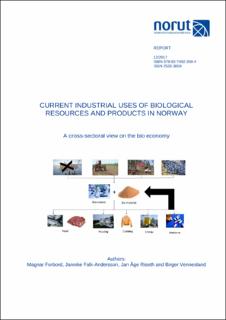| dc.description.abstract | The bio economy is a wide phenomenon encompassing a broad resource base on land and in the oceans. The possibilities for future developments are huge. Traditionally each sector in the bio economy (forestry, agriculture, fisheries, aquaculture and related industries) operates separately and there have been few cross-sectoral studies. This report contributes to remedy this shortcoming by offering a “wide-angle” view on the bio economy studying industries in all the major sectors in parallell. The study concerns bio economy in Norway. The report answers these questions: 1) What types of products are produced in the different (industrial) sectors when it comes to main products and by-products? 2) What are the capacities and types of businesses in the various sectors? 3) What kind of connections can be observed between different industrial sectors in the bio economy? The report builds on a previous report on resources in the primary sectors of the bio economy (Falk-Andersson et al., 2016). The report starts with a definition of central terms, such as main product, by-product and waste and a discussion of the value pyramid. For each sector, we provide a description of main products and by-products. The sectors differ hugely in character, from agriculture and reindeer herding as predominantly domestic industries, to forestry, fisheries and aquaculture, which are aimed at export. We combine different types of secondary data for the descriptions: public statistics, especially business statistics from Statistics Norway, and various reports, public documents and web information. By-products represents an increasingly important product category because of the need to focus simultaneously on sustainability and economy in society. Another major issue is the balance between specialization and integration. Much of the development of products and processes in the bio economy occurs in the form of specialization in the sectors. However, integration is necessary to avoid a total atomistic bio economy. In recent years we observe interesting examples of developments across sectors in the bio economy, such as production of biogas from by-products from aquaculture and forest industry. Another example is the combination of food products from agriculture and seafood to enhance the service product in the tourism and hospitality industry. The bio economy has a large potential to fill societal needs in the future, when it comes to food, feed, and fiber, as well as energy, new materials, health and recreation. | en_US |
